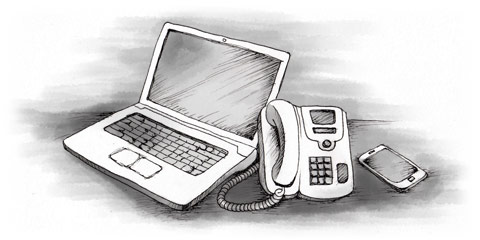The tangle of incompatible standards for cellular, wireless, or mobile phones in the world is similar to the jumble of conflicting television standards around the globe (NTS, PAL, SECAM) only worse. At least with TV standards, the entire country is under one system. In the US alone, there are dozens of incompatible mobile phone systems. In Europe the situation is better, but the Europeans and much of the world have gone one way in cell phone technology, while North Americans have largely gone another.

In Europe the GSM (Global System for Mobile communications) digital mobile phone system is used for German Handys and digital cell phones across most of the continent. Germany has four main competing digital phone standards: D1, D2, E2, and e-plus (all are GSM). In the Americas, the wireless phone situation is much more tangled. There are several different major digital systems. To really understand it all, you need to know terms like CDMA, TDMA, PCS, and other tech abbreviations.
Attempts to achieve a world-wide mobile phone standard have been thwarted by competing technology companies and political interests — even resulting in a dispute between the US and Europe over a universal mobile telephone standard. Europe has largely achieved digital wireless standardization already with the GSM system, while the US and Canada have incompatible digital networks run by competing operators using either CDMA (code division) or TDMA (time division) technology. But there is now a growing trend towards GSM in the US by Cingular and other vendors. GSM wireless systems also exist in the US (T-Mobile and Cingular), but they use a different frequency band than the European GSM systems.
To see the true worldwide dominance of GSM, just look at these figures (number of subscribers):
- GSM: 331.5 million* (130 countries in Europe, Asia, Africa, etc.)
- CDMA: 67.1 million (US, Canada, S. Korea)
- PDC: 48.2 million
-
TDMA: 47.8 million (US, Canada)
*Includes 900, 1800 and 1900 GSM systems
Sources: Wall Street Journal, GSM World, EMC World Cellular Database Quarterly. As of mid-2000.
This means that GSM has more users worldwide than all the other digital wireless systems combined. It also means that your US mobile phone is useless in most other parts of the world. But see below...
Possible Solutions
For North Americans going to German-speaking Europe or vice versa, there are several possible solutions to the Handy dilemma:
1 Rent a GSM cell phone during your trip to Europe. Nextel, Cingular and several other companies rent out GSM wireless phones on a short term basis. Using a SIM card in a rental even allows you to use your home mobile phone number in Germany. But renting may be more expensive than buying—especially for long-term rentals. Even though they have come down somewhat, the per-minute charges are higher also, because even a local call in Europe is a long distance call on an Cingular or Nextel phone. Rental phones also tend to be “locked” so that they can not be used with other (German, European) SIM chips.
2 Buy a multi-band GSM cell phone that can function in the several incarnations of the GSM system—in Europe and North America. Such phones are made by companies such as Bosch, Qualcomm, Siemens, Motorola, Nokia, and Ericsson. You can buy one before you leave or in Europe, but you must be aware of the difference between US and European GSM phones. A dual-band Cingular/T-Mobile Nokia 8890, for instance, will allow you to use your wireless phone in both the US and European GSM networks.
3 Buy a GSM prepaid wireless phone in Germany that includes call time. You can buy a decent cell phone in Germany for under US$100 (€ 100) that includes prepaid minutes and a “refillable” SIM chip. The per-minute rate for a typical Xtra or CallYa prepaid phone is higher than with a cell-phone contract, but you get to choose one number you can call for a much lower rate and you don’t need to have a German address or a German fixed network phone number, a distinct advantage for travelers. For some people, particularly business people who want to use their US cell phone number in Germany, methods one or two might be better. However, a prepaid Handy is the cheapest, most hassle-free way. On weekends, prepaid wireless calls to any local number are only about 10 cents/min. There are German “Handy” stores on almost every block of any shopping district. You can even buy the prepaid phones in many German department stores and shopping malls. Many German sales people also speak English, if that’s a problem for you.
Another Option: Buy an unlocked GSM phone that can be used with any SIM chip. If you buy a European mobile phone that is unlocked, you are free to use any chip (even a Cingular SIM from the US) with it. A good unlocked phone will run about $120-200 in most of Europe. But if it's not a multi-band model, it can only be used in Europe or other GSM regions. This is a good option for people who will be in Europe frequently.
4 Iridium Sat Phone | The Iridium global satellite phone option almost vanished not long ago when Iridium went into Chapter 11 bankruptcy. The new Iridium is a much more attractive option than before. Iridium now offers smaller, lighter phones, free incoming calls and a more competitive rate of $1.50/min. for outgoing calls. There are currently several global satellite phone options available from Iridium, Globalstar, and others. With any satellite phone, the main drawback is the cost of the handset itself, usually running around $1,000.
No One Solution for All
Since no single solution is best for everyone, you’ll have to make a decision based on your own requirements. If you will be going back and forth between Europe and North America fairly often, you may want a single phone that is compatible with the various GSM systems. But you can also use a GSM phone in Europe and your regular US wireless phone at home. (Remember that GSM networks on both sides of the Atlantic use differing frequencies.
Most GSM phones also take advantage of SIM card technology, a tiny smart card that can be inserted in the phone to allow the use of more than one phone number. This makes it possible, for example, to use your home phone number and a European number on the same phone.
------------------------
This article in an extract from " When in Germany " by Hyde Flippo, a practical guide to German life, language, and culture. Click here to get a copy of the book.


